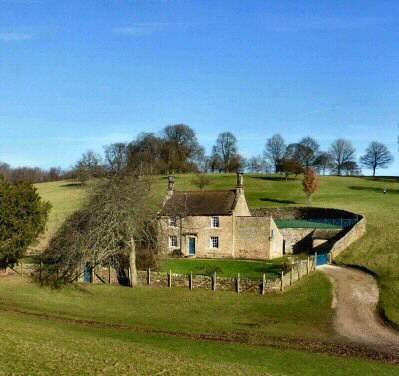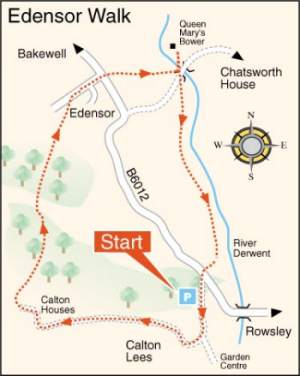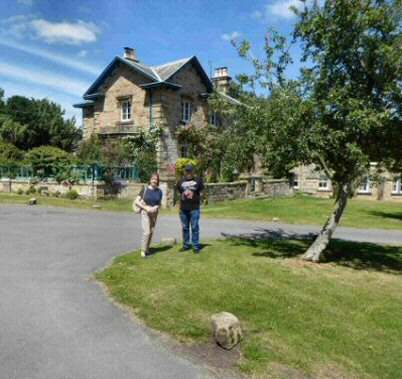EDENSOR AND CHATSWORTH PARK WALK
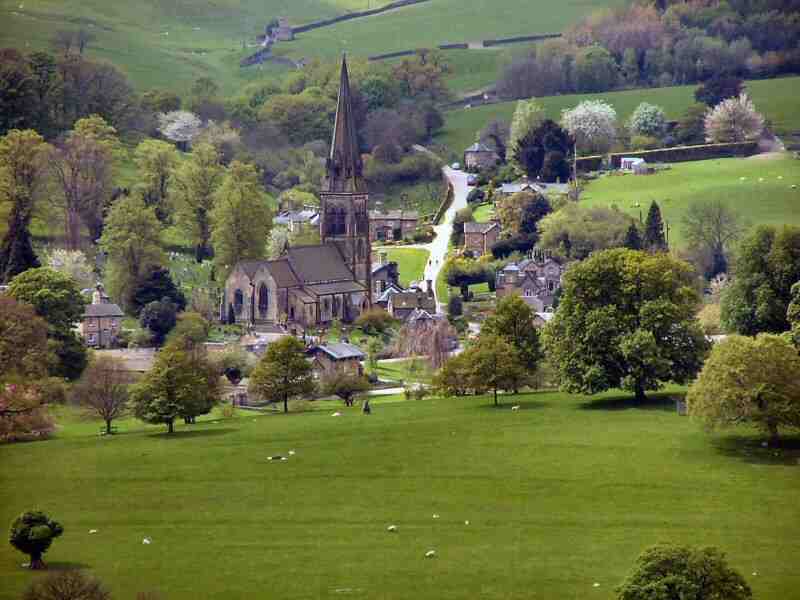
THE WALK
The Edensor and Chatsworth Park Walk is a leisurely walk through beautiful parkland where deer roam freely. It has outstanding views of Chatsworth House and a chance to explore Edensor, one of Derbyshire’s finest and most unusual villages. St Peter’s Church and graveyard are also worthy of extensive exploration.
The walk starts from Calton Lees Car Park and climbs to Calton Houses Farm before passing the much-admired Russian Cottage. A gift to the 6th Duke of Devonshire from Tsar Nicholas of Russia, with whom he was good friends. The two men planned to meet, but unfortunately, the Tsar had to cancel. According to recent research, the Tsar’s brother sent an intricate model of a Russian farmhouse to the 6th Duke as a gesture of friendship, which motivated the Duke to build the Russian Cottage.
The views are stunning as you leave New Piece Wood and walk towards Edensor, with Stand Woods towering above Chatsworth. It is a good time to look for deer grazing in the park and sheep wandering across the road in front of Chatsworth House. The sheep take their time and often make motorists wait as they walk along the road.
After visiting Queen Mary’s Bower, you continue your walk along the path by the River Derwent, which has superb views of Chatsworth House and gardens.
LOOK OUT FOR
Route Point 1 – The hamlet of Calton Lees is beautiful in the summer, with its rich, honey-coloured stone cottages and stunning gardens. Chatsworth estate workers tenant the cottages. It is always easy to recognise properties owned by the estate by the blue-painted doors. The well-liked Chatsworth Garden Centre is on the left, where the public road ends. It is a popular stopping point for walkers and visitors who arrive by car. Between the garden centre and the road through Chatsworth Park is a large pay-and-display car park, ideal for a picnic or the starting point for a walk.
Point 5 – The Russian Cottage was a gift from Tsar Nicholas of Russia to the 6th Duke of Devonshire in 1855. The two men had become friends following the Duke’s visit to Russia in 1816, when he served as the British Ambassador to Moscow. They planned an exchange visit, but unfortunately, the Tsar had to cancel. Instead, he sent an intricate model of a Russian Cottage as a keepsake. The cottage is the latest and perhaps the most fascinating holiday cottage on the estate.

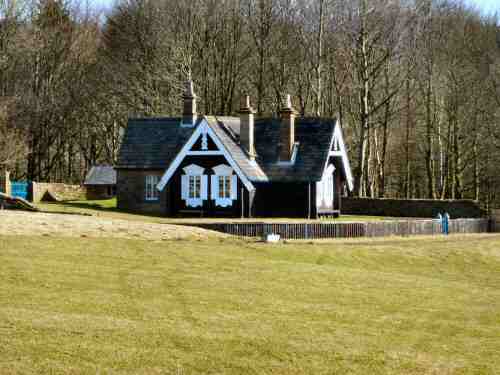
Point 6 – There are magnificent views across the park towards Chatsworth House and beyond Stand Wood and the Hunting Tower. The Hunting Tower is Elizabethan in construction and stands on the escarpment 400 feet above Chatsworth House, on the edge of Stand Wood. It has magnificent views over Chatsworth Estate, which the ladies of the house enjoyed when viewing the hunt in the park below. The cannon at the house’s base came from a ship that fought at the Battle of Trafalgar. In 2006, a small stone building at the foot of the tower, together with the tower, was converted to provide a holiday let for large groups.
Point 7 – St. Peter’s Church contains one of the finest monuments in the county. In the church, in a glass case, is a wreath of everlasting flowers sent by Queen Victoria to the funeral of Lord Frederick Cavendish, tragically killed in Ireland while on a peace mission. Joseph Paxton is buried in the churchyard in a grave of a much grander scale than that of his master, the 6th Duke. The grave of the 11th Duke of Devonshire and his wife is modest. Near the top of the churchyard is the grave of Kathleen Kennedy, the sister of the late President of the USA. She was the wife of the previous Duke’s elder brother and heir to the Dukedom, who tragically was killed in Belgium during the last war. Only four years later, his wife died in an air crash.
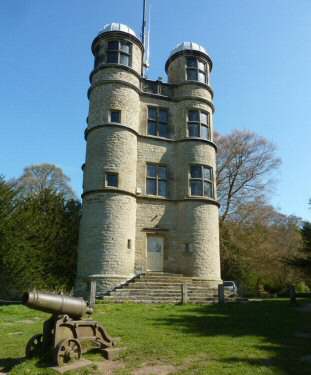
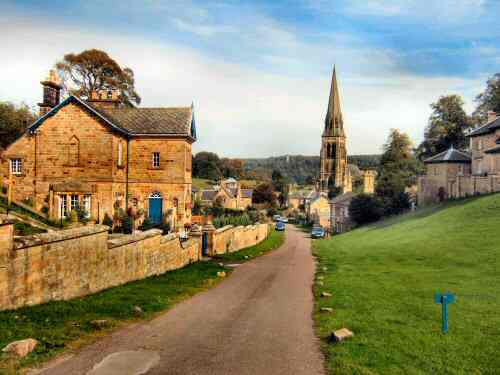
Point 9 – Edensor, pronounced “Enzer”, is mentioned in the Domesday Book but has been re-sited since then. Initially, it lay between the river and the drive through the park, where the houses ran down the road in an untidy line. This arrangement did not appeal to the 4th Duke of Devonshire, who had spent considerable money and effort improving Chatsworth House, redesigning the gardens and building a brand-new bridge over the river. He decided to demolish the houses visible from his home. The tenants were safely re-housed in the nearby estate villages of Pilsley and Beeley before the demolition work commenced. The Duke died in 1764 before the completion of the job, and it was the 6th Duke who completed the building of the present village.
Point 10 – Chatsworth House and gardens provide lovely views as you walk along the banks of the River Derwent. Lancelot (Capability) Brown landscaped the 105-acre gardens, with the imposing Emperor Fountain the most impressive landmark. It was built in 1844 to impress Czar Nicholas of Russia. Unfortunately, the Czar was detained elsewhere and failed to visit Chatsworth. The fountain’s single gravity-fed high spout rises to 290 feet and is the tallest in Britain.
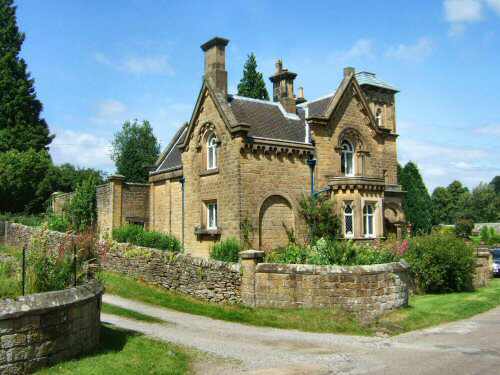
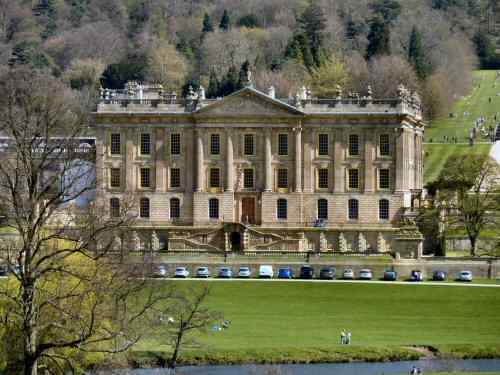
WALK DETAILS
Length: 4 miles.
Start: From the south, take the B6012 road signed for “Chatsworth House” off the A6 Matlock to Buxton Road. Calton Lees Car Park is east of Chatsworth House, on the B6012, shortly after crossing the bridge over the River Derwent (SK259685).
Terrain: Easy walking along tracks, through fields and parkland. There is a steady climb to Calton Houses and a descent to Edensor.
Refreshments: The Attractive Edensor Tea Cottage is open daily, and a wide range of refreshments is available at Chatsworth House. Beeley and Pilsley have lovely, old traditional pubs, both rather confusingly called the Duke of Devonshire.
THE ROUTE
1. Leave the car park, go through the gateway to the right of the Garden Centre, and follow the road, which angles to the right through the pretty hamlet of Calton Lees.
2. Just after a triangle of grass in the middle of the road, take the centre of three gateways leading up a long lane.
3. After gradually climbing upwards for about one mile, the lane bends sharply right and left through a farm gateway at Calton Houses.
4. Continue along a stony track, leaving by a wooden gate, turning right alongside a wall, and walking straight ahead when the field opens out.
5. Follow a clear path across the field with The Russian Cottage a short distance to your right.
6. A few yards beyond a path junction, cross a stile into a small wood. Follow a walled track to a ladder stile with the Chatsworth Estate parklands stretching out in front of you and Stand Wood and the Hunting Tower seen in the distance.
7. Walk downhill towards the spire of St Peter’s Church, keeping to the left of two fenced tree enclosures.
8. Gradually bear to the left of the church and churchyard, go through an iron swing gate close to a house on the left and descend a flight of steps to the road.
9. Cross the road and follow the path to the right into Edensor village, walking past the village green to the main road.
10. Continue along the surfaced track on the opposite side of the road as it bends to the right to the bridge over the Derwent leading to Chatsworth House.
11. Go over the bridge to visit Queen Mary’s Bower, visible on the left. Retrace your steps across the bridge and turn to the left alongside the river in front of Chatsworth House.
12. Continue along the path by the River Derwent, with excellent views of Chatsworth House and gardens to your left. As you approach a derelict mill, turn right and walk up the slope to the road through the park. On joining the road, turn left and follow the signed path back to the car park and the start of the walk.
Edensor
